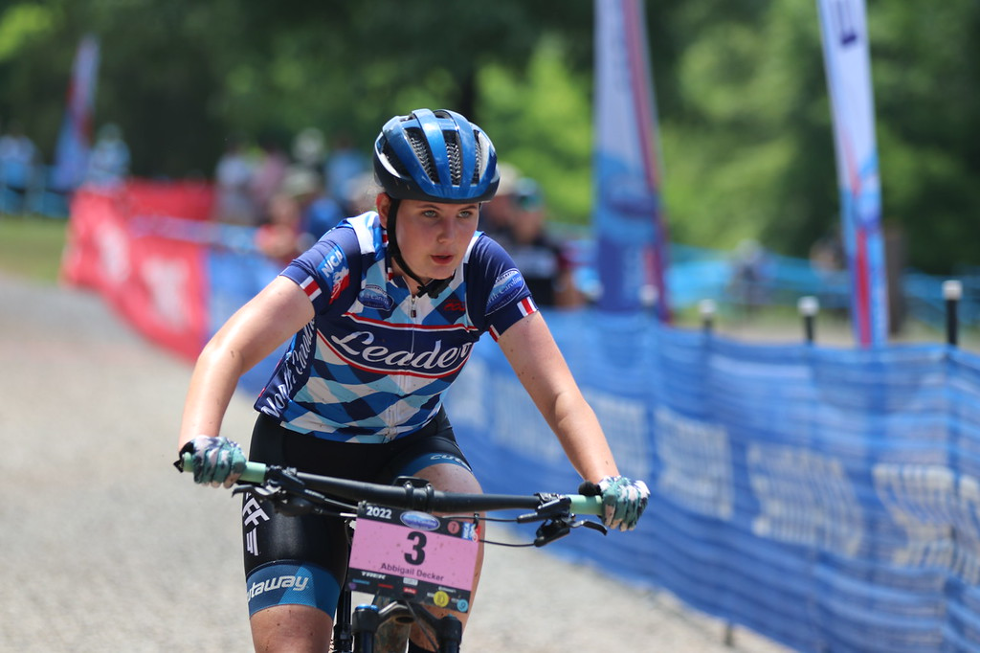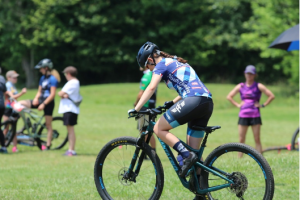Student Athlete Beats the Odds in Dealing with Vocal Cord Dysfunction

In July of 2021, 16-year-old Abbie Decker was gearing up for a competition in the USA Cycling Mountain Bike National Championships in Winter Park, Colorado. At a competition 9,000 feet above sea level, the air is thin, the trails are steep, and tensions are high.
Decker, who has been mountain biking with her father since she was a young girl and competitively mountain biking since she was in the sixth grade, recalls that in the weeks leading up to the races, she was having difficulty catching her breath while training.
“I spent a week just below Winter Park, and then a week at the park,” Decker says. “When the races started, I was constantly out of breath, and I had this really painful tightness in the top of my chest and in the lower throat area.”
Decker had previously been diagnosed with sports-induced asthma. She assumed that her discomfort was a combination of her asthma and the higher altitude.
Then, the unthinkable happened.
“I went to do our short track race, which is a cross country race with just a shortened track, and you race for 30 minutes,” Decker says. “I made it two laps in, maybe a mile or so, and I was pulled. I could not breathe. I was lightheaded and I was banging on my chest to try to relieve how much pain I was in.”
Decker says that she was able to breathe out, but couldn’t get any air in. At the emergency room, x-rays revealed that her lungs were filled with fluid. The next day, when she returned still in pain, her oxygen level was at an alarming 70%.
Her physicians assumed she had altitude sickness, and after some treatment and starting a course of steroids, her oxygen level returned to normal and she was able to race again a few days later.

"There are a lot of different triggers, but usually we see [vocal cord dysfunction] in people when they’re having a change in their activity level."
A Misdiagnosis
When Decker returned home, however, her symptoms returned in full force. At that point, Decker and her family realized that her condition was more than altitude sickness, and possibly even more than asthma.
Decker was referred to a pulmonologist, but test after test revealed that her lungs were healthy, even above average.
Then came an important realization that she hadn’t thought to share with her doctors previously.
“We discussed what these moments were like of not being able to breathe,” Decker says. “That’s what finally helped. With asthma, it’s breathing out that’s the issue, and I was having trouble with breathing in. That was the big moment when my doctors realized that this wasn’t the problem they thought they had been treating for the last six years.”
A final referral to Duke Otolaryngology provided an answer. As it turns out, Decker didn’t have asthma at all—she has a condition known as Vocal Cord Dysfunction, or VCD for short.
What is Vocal Cord Dysfunction?
![Decker [foreground, right] starts a race in the North Carolina Interscholastic Cycling League. She would go on to win this race, beating her second-place opponent by 17 seconds.](/sites/default/files/2023-04/vcd2-300x200.png)
Eileen Raynor, MD, Associate Professor and pediatric head and neck surgeon at Duke, says that VCD is often misdiagnosed.
“Vocal cord dysfunction occurs when something triggers the vocal cord to try to protect the airway, and then tries to close when breathing in,” Dr. Raynor says. “This is as opposed to opening, which is what should happen. It then creates a small air space. There are a lot of different triggers, but usually we see it in people when they’re having a change in their activity level.”
To help visualize what the throat looks like during a VCD episode, Dr. Raynor uses an analogy that many teenagers are familiar with: boba straws, or the straws used to drink smoothies. The normal airway is the size of a boba straw—but for patients with VCD, they are often trying to breathe through an opening the size of a coffee stirrer.
Anxiety during an episode can also strengthen the intensity of a flare-up, as the body tenses and tightens. For Decker, who was competing in a national competition, she was already in a high-adrenaline state during her episode in Colorado.
Relearning How to Breathe

After being diagnosed with VCD, Decker met with Speech Pathologist Meghan Esper, CCC-SLP. Surgery is an option for patients with severe VCD, but for Decker, learning new breathing techniques has helped to lessen many of her symptoms.
Esper says that restrictive breathing exercises are helpful for patients with VCD. When a patient has an episode, it can help to breathe through a forced smaller opening of the lips, or through the nostrils.
Because the body usually fights against breathing through two points of restriction, these techniques can help the vocal cords to relax and open the airway.
“With teenagers especially, I’ll start by reiterating that the vocal cords opening and closing are the last line of defense before the windpipe or their trachea,” says Esper. “With VCD, the vocal cords are pulled together so the airway is very narrow. I remind them that on the scope, we could see that when they breathe through a restricted opening, everything opened up within seconds. So even if your brain is telling you can’t get air in, if you breathe this way, it will help.”
Decker says these techniques have given her necessary tools.
“One thing that has definitely helped has been going to the speech therapy appointments, and learning how to calm down and focus on breathing,” says Decker. “You have to retrain yourself how to breathe, by creating tensions in other places and not in my throat. I need to remember during a race to focus on my breathing while I’m focusing on the race as well.”
Good Posture is Also Key

During treatment, Esper realized that mountain biking in particular was also a contributing factor to Decker’s VCD episodes: while hunched over on her mountain bike, Decker was naturally restricting her airway.
“It was so eye-opening to realize this,” says Esper. “When I pushed down on her shoulders while she was on a massage table, there was so much tension from her stance on the bike from leaning forward. Once we addressed her posture to reduce this tension, she was able to access a more natural breathing pattern and breathe more diaphragmatically.”
“I had to focus on bringing my shoulders back and up, especially on the bike, and keeping my posture up,” says Decker. “My cycling coach helped me with this too, to learn how to keep my back straight and lean forward, rather than hunching forward.”
This stance has even helped her performance. Decker says she feels she has more power in her legs while cycling, and is far more efficient.
Raising Awareness

Decker hopes that sharing her story and experience with VCD will help others who may be misdiagnosed with asthma or other conditions.
“I think focusing on the small, little cues is important,” Decker says.
Through a correct diagnosis and learning strategies to cope with her condition, Decker feels she has more control and can be a better competitor.
“I can control this a lot better, and that is really something,” Decker says. “I know how to stop it from happening and how to prevent it from happening. When I’m racing, my parents sometimes will remind me to focus on my breathing, and I’m able to regain myself, collect myself, and keep going. That was something I had a really hard time doing before.”
Now that she has the tools she needs, Decker is back on the bike and back to winning races. She recently competed for a state championship, going neck and neck with one of her teammates. Decker needed to win this last race to tie for the state championship.
“I beat her by 17 seconds,” Decker says, smiling. “It was great.”